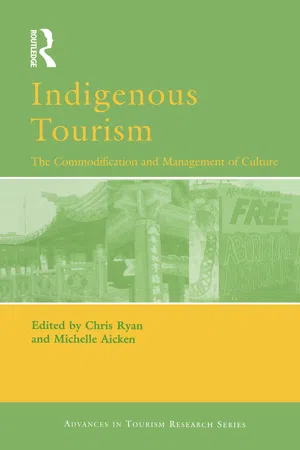Geography
Indian Reservations in the US
Indian reservations in the US are designated areas of land managed by Native American tribes under the US government's jurisdiction. These reservations are sovereign nations with their own laws and governance, and they often have a unique cultural and historical significance. The establishment and management of Indian reservations have been a complex and contentious issue throughout US history.
Written by Perlego with AI-assistance
Related key terms
3 Key excerpts on "Indian Reservations in the US"
- eBook - ePub
- John R. Gold, George Revill, John R. Gold, George Revill(Authors)
- 2014(Publication Date)
- Routledge(Publisher)
There are just less than two million Native Americans in the United States. Most belong to tribes or cultural groups that occupy diverse environments and typically have their own languages and real or mythical lineages. The US government formally recognises over 330 American Indian tribal groups in the lower forty-eight states and 223 Alaska Native groups. Some of these have petitioned for recognition (BIA 1999a), others for re-recognition (Wilkinson 1992). According to the US Census Bureau, in 1990 about one-quarter of all Indians lived on reservations, with another quarter living close enough to reservations to make frequent trips for family visits and ceremonies. Not all tribes have reservation lands, and some new reservations have been created in recent years. However, each reservation maintains a distinct and separate tribal government and administrative structure. Depending on the definition used, the federal government recognises around 275 to 300 reservations, rancherias and other land-based communities, while states recognise an additional twelve. These Indian lands total 55 million acres, with individual reservations ranging in size from less than 1 acre to more than 17 million acres in the case of the Navajo Reservation. Some tribes are adding to their reservation land base by purchasing non-reservation lands and placing them under federal government trust. Approximately 20 percent of the federally recognised reservation lands are privately owned by individual Indians, while the remainder is held in trust by the federal government and reserved for tribal use (BIA 1999b).Figure 9.1 Map of Arizona and New Mexico showing the location of federal Indian reservations and major towns (map by Tina Kennedy)Reservations were established to protect non-Indians from the military threat of ‘captive nations’ (Snipp 1994) and are central to the federal government’s policy towards Native Americans (Wilkinson 1992). The first true reservations were established by the state of California shortly after the discovery of gold brought a huge influx of non-Indians to the state (Findlay 1992). The apparent success of this Californian solution to the ‘Indian problem’ quickly spread throughout the west. In most instances, tribes were forced on to reservation lands through a form of forced dependency. Hunting tribes could no longer survive as the open ranges were subdivided and the US Army and other hunters killed nearly all of the buffalo around which their lives revolved (Hagan 1993). The Army also destroyed fields and orchards to force tribal groups on to reservation lands, where they could at least obtain government handouts of food and shelter. The policy was a conscious effort to respond to the American public’s desire for more land and access to resources by concentrating, weakening or even eliminating the only potential threat to that desire, the American Indian. - eBook - ePub
Behind Barbed Wire
A History of Concentration Camps from the Reconcentrados to the Nazi System 1896-1945
- Deborah G. Lindsay G. Lindsay(Author)
- 2020(Publication Date)
- Universal-Publishers(Publisher)
Chapter Three American Indian Reservations—Martin Luther King, Jr.Our nation was born in genocide when it embraced the doctrine that the original American, the Indian, was an inferior race … From the sixteenth century forward, blood flowed in battles over racial supremacy. We are perhaps the only nation which tried as a matter of national policy to wipe out its indigenous population. Moreover, we elevated that tragic experience into a noble crusade … Our children are still taught to respect the violence which reduced a red-skinned people of an earlier culture into a few fragmented groups herded into impoverished reservations.244P rior to its use of concentration camps in the Philippines, the United States government had targeted an “undesirable element” in its own society—the Native Americans. Judging these indigenous people as a threat to the general public, the military confiscated the lands and personal property of the Southeastern Indians and forcibly relocated them into isolated areas west of the Mississippi River. Guarded by the military, the Indians were effectively segregated from mainstream population, i.e., the white citizens. The nomadic tribes of the West, considered an impediment to westward progress of the mostly European white settlers who intended to develop farms and ranches on the vast American plains, were also corralled into stagnant locales that deprived the tribes of their hunting tradition. Although the government labeled these resettlement areas by the more benign term, reservations - eBook - ePub
- Michelle Aicken, Chris Ryan(Authors)
- 2010(Publication Date)
- Routledge(Publisher)
This chapter evaluates several case studies of sustainable tourism developments that have been established on reservations as a means of cultural, environmental, socio-economic and political sovereignty. The case study analysis highlights the factors of sustainable tourism and how incorporation of certain elements into reservation development is essential to the sustainable development and management of American Indian reservations. This work helps fill a gap in the existing knowledge about contemporary American Indian tourism through this review which leads to an assessment of those factors which create successful, sustainable tourism developments. By understanding these factors, other American Indian reservations could adopt more sustainable tourism policies. Sustainable development is essential for all communities, especially those who have perceived themselves as victims of exploitation in the past. Therefore, it is important to implement culturally appropriate, sustainable developments into tribal communities.American Indian Socio-Economic Condition
American Indian tribes currently own approximately 52 million acres of federally recognized reservation land. Reservation lands are held in trust by the United States government for the tribes' occupancy and benefit. Many American Indian reservations, however, lack the bare necessities of modern life, such as running water, indoor plumbing, electricity, or telephones, not to mention the basic infrastructure components of police, fire, sanitation and health and education. Expanding population bases, limited land space, destructive economic developments, diminishing water resources, deteriorating infrastructures and many social ills are the reasons why the American Indians especially need to develop sustainable land uses which do not jeopardize their community and environment.Reservation Tourism Development
Given the socio-economic status of American Indian reservations, it has become apparent that some type of economic development is needed for the revitalization of tribal communities. While the U.S. government has attempted to develop reservations through resource extraction, most of these strategies have failed. Many studies indicate that tourism has been widely accepted by American Indian reservations as an economic development tool (Hill 1992 ; Lew 1996 ; Rudner 1994 ; Sweet 1991 ; White 1993 ). Lew (1996)
Index pages curate the most relevant extracts from our library of academic textbooks. They’ve been created using an in-house natural language model (NLM), each adding context and meaning to key research topics.


